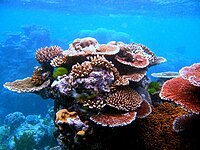
Genetic structure of dinoflagellate symbionts in coral recruits differs from that of parental or local adults
Sign Up to like & getrecommendations! Published in 2022 at "Ecology and Evolution"
DOI: 10.1002/ece3.9312
Abstract: Abstract The symbiotic relationship between dinoflagellate algae in the family Symbiodiniaceae and scleractinian corals forms the base of the tropical reef ecosystem. In scleractinian corals, recruits acquire symbionts either “vertically” from the maternal colony or… read more here.
Keywords: coral recruits; dinoflagellate; symbionts coral; dinoflagellate symbionts ... See more keywords

Dinoflagellate-targeted PCR reveals highly abundant and diverse communities of parasitic dinoflagellates in and near Zhubi Reef, South China Sea
Sign Up to like & getrecommendations! Published in 2021 at "Coral Reefs"
DOI: 10.1007/s00338-021-02168-w
Abstract: While diversity of symbiodiniacean dinoflagellates has been a focus of coral reef ecological research, information on the diversity of planktonic dinoflagellates in reef ecosystems remains limited. We used dinoflagellate-targeted PCR to investigate dinoflagellate diversity for… read more here.
Keywords: diversity; dinoflagellate targeted; sea; dinoflagellate ... See more keywords

Evidence for the presence of cell-surface-bound and intracellular bactericidal toxins in the dinoflagellate Heterocapsa circularisquama.
Sign Up to like & getrecommendations! Published in 2017 at "Aquatic toxicology"
DOI: 10.1016/j.aquatox.2017.06.016
Abstract: Heterocapsa circularisquama, a harmful dinoflagellate, has multiple haemolytic toxins that are considered to be involved in the toxic mechanism against shellfish and certain species of zooplankton. To evaluate the further nature of the toxins of… read more here.
Keywords: bactericidal; heterocapsa circularisquama; dinoflagellate; circularisquama ... See more keywords

Study of a hydrodynamic threshold system for controlling dinoflagellate blooms in reservoirs.
Sign Up to like & getrecommendations! Published in 2021 at "Environmental pollution"
DOI: 10.1016/j.envpol.2021.116822
Abstract: Hydrodynamic conditions often affect the eutrophication process and play a key role in algal growth in reservoirs. A promising approach for controlling algal blooms in reservoirs is to create adverse hydrodynamic conditions by implementing reservoir… read more here.
Keywords: dinoflagellate blooms; dinoflagellate; blooms reservoirs; controlling dinoflagellate ... See more keywords

Accumulation and depuration of paralytic shellfish toxins by Australian abalone Haliotis rubra: Conclusive association with Gymnodinium catenatum dinoflagellate blooms
Sign Up to like & getrecommendations! Published in 2017 at "Food Control"
DOI: 10.1016/j.foodcont.2016.10.012
Abstract: Paralytic shellfish toxins (PST) were detected in abalone (Haliotis rubra) in April 2011 in south-east Tasmania, Australia, during a dinoflagellate bloom of Gymnodinium catenatum. This led to restrictions on abalone harvesting and triggered continued PST… read more here.
Keywords: abalone haliotis; abalone; shellfish toxins; dinoflagellate ... See more keywords

Molecular approach for analysis of in situ feeding by the dinoflagellate Noctiluca scintillans.
Sign Up to like & getrecommendations! Published in 2020 at "Harmful algae"
DOI: 10.1016/j.hal.2020.101928
Abstract: The red tide forming heterotrophic dinoflagellate Noctiluca scintillans is common in temperate to tropical waters around the world. Understanding the in situ prey of N. scintillans is essential for elucidating its role in marine microbial… read more here.
Keywords: analysis situ; molecular approach; noctiluca scintillans; approach analysis ... See more keywords

Middle Miocene dinoflagellate cyst assemblages and changes in marine productivity in western Colombia
Sign Up to like & getrecommendations! Published in 2021 at "Marine Micropaleontology"
DOI: 10.1016/j.marmicro.2021.102024
Abstract: Abstract Changes in dinoflagellate assemblages indicate regional paleoceanographic events affecting western Colombia. Integration of palynomorph, planktonic foraminifera, and calcareous nannoplankton data from a 616 m thick outcrop section in the Ladrilleros-Juan Chaco region allows the construction… read more here.
Keywords: western colombia; miocene dinoflagellate; cyst assemblages; productivity ... See more keywords

Pyritization of dinoflagellate cysts : a case study from the Polish Middle Jurassic (Bathonian)
Sign Up to like & getrecommendations! Published in 2017 at "Review of Palaeobotany and Palynology"
DOI: 10.1016/j.revpalbo.2017.07.005
Abstract: Abstract Bathonian mudstones and claystones were deposited in a shallow epicontinental sea of the Polish Basin (the Ore-Bearing Czestochowa Clay Formation). They are represented by two units, differing in stratigraphical and facies development. Dinoflagellate cyst… read more here.
Keywords: pyritization; dinoflagellate cysts; cysts case; dinoflagellate ... See more keywords

The temporal and spatial distribution of Triassic dinoflagellate cysts
Sign Up to like & getrecommendations! Published in 2019 at "Review of Palaeobotany and Palynology"
DOI: 10.1016/j.revpalbo.2018.11.010
Abstract: Abstract The records of fossil dinoflagellate cysts from the Late Triassic, the time during which they first appear abundantly in the geological record, are reviewed. Most of the Triassic palynological literature pertains to terrestrial palynomorphs,… read more here.
Keywords: dinoflagellate; temporal spatial; triassic dinoflagellate; dinoflagellate cysts ... See more keywords

Scrippsiella masanensis sp. nov. (Thoracosphaerales, Dinophyceae), a phototrophic dinoflagellate from the coastal waters of southern Korea
Sign Up to like & getrecommendations! Published in 2019 at "Phycologia"
DOI: 10.1080/00318884.2019.1568794
Abstract: ABSTRACT A phototrophic dinoflagellate belonging to the genus Scrippsiella was isolated from a water sample collected from Masan Bay, Korea. Using a clonal culture of this dinoflagellate, its morphology was analysed with light, scanning and… read more here.
Keywords: phototrophic dinoflagellate; masanensis nov; scrippsiella masanensis; dinoflagellate ... See more keywords

Morphology and molecular phylogeny of a widely distributed but little-known sand-dwelling phototrophic dinoflagellate, Coutea sabulosa gen. & sp. nov. (Dinophyceae, Alveolata)
Sign Up to like & getrecommendations! Published in 2023 at "Phycologia"
DOI: 10.1080/00318884.2023.2188006
Abstract: ABSTRACT A new thecate, photosynthetic, sand-dwelling marine dinoflagellate, Coutea sabulosa gen. & sp. nov., observed in various locations from temperate to subtropical areas, is described based on detailed morphological and molecular data of material from… read more here.
Keywords: sand dwelling; dinoflagellate coutea; dinoflagellate; gen nov ... See more keywords